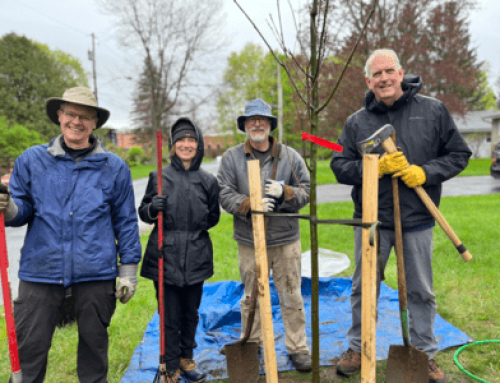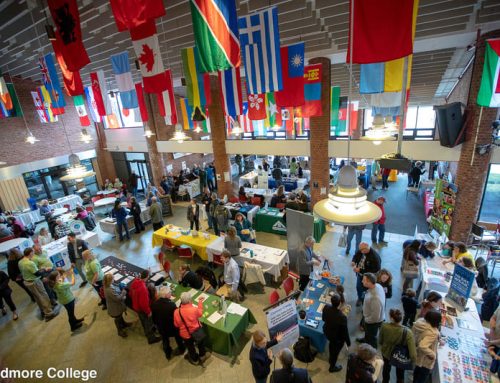
Skidmore professors Karen Kellogg and Mark Youndt live in a net-zero home in Greenwich that they designed themselves. Completed in 2013, their home combines passive solar design with a rooftop photovoltaic system to produce more fossil-free energy than it consumes each year.
Mark and Karen’s house is not the only green building on their property. During the Covid-19 pandemic, they have been joined at home by their daughter, Colby Kellogg-Youndt, a Biology and Environmental Studies major at St. Lawrence University. Colby is putting the finishing touches on a tiny house that she intends to live in after she graduates this spring.
Karen and Colby sat down with Sustainable Saratoga to share their experiences in green construction and low-carbon living. We start with our conversation with Karen, which has been edited for clarity. Click here to read our interview with Colby and learn more about the tiny house movement.
Sustainable Saratoga (SS): We’ll start with the main house. Karen, could you please tell us about your background and how you came to build your home?
Karen Kellogg (KK): I teach in the Environmental Studies and Sciences program at Skidmore. I teach a course on renewable energy and an environmental engineering class, among other things. I have an undergrad degree in engineering and a PhD in ecology. Mark, my husband, has always loved to build things, and he taught Colby how to build things, so there are always projects going on in our house.
Mark was the general contractor for this house. He and I had been collecting and sketching out ideas for years—ten, fifteen years or more. When we moved over to Greenwich, we finally had the opportunity to build our own home. And we found a piece of land that had great southern exposure that allowed us to build this house.
SS: What were your guiding principles?
KK: We made a few of decisions early on. For example, we were not going to go over 1400 square feet. In most regions of the world, that’s incredibly luxurious, but in the United States, that’s pretty small by current new build standards. We also wanted to not have any fossil fuels on the property. We wanted to use as much local material and local labor and expertise as possible. And we wanted to use as much recycled material as possible. Those were some things we decided out of the gate, and you’ll see all of them wrapped into this house.
Finally, we wanted to build a house that a typical person could see themselves in, where you didn’t have to monitor a lot of things, and it looks and feels like a typical home. We have a lot of friends who did off-grid, straw-bale, and other amazing building projects. I personally love straw-bale construction, but it’s a different kind of look and a different kind of feel. We wanted to build a house that an average family could see themselves living in, so we picked this contemporary farmhouse design.

SS: One essential feature of your house is its passive solar design. How does passive solar work?
KK: The southern face of the house is comprised mostly of windows and glass doors, so we get great sunlight coming in on that side. And then we have overhangs that are really exaggerated. In winter, the sun tracks low in the sky, so the sun’s rays come into our house. But in the summer, it tracks higher up in the sky, and the large overhangs block the sunlight. So it stays fairly cool in the summer, but takes advantage of that solar gain in the winter months.
Down the middle of the house is a thermal mass. It’s basically a cinderblock wall that’s filled with cement, and then there’s a stone face to it. As the sun comes in, it heats up the thermal mass during the day, and then it radiates heat into the evening hours. I got this idea from Hudson Valley Community College. One of their sustainable classroom buildings has something like this right down the center of it.
The passive solar alone is huge. We can leave for two weeks in the winter, like we do for the holidays, and without leaving any heat on or anything, it will stay 55 degrees in here. It’s incredibly effective. We don’t have a central heating system. We do have a woodstove in the middle of the house and a small mini-split that we use, which is a very energy efficient little heating and air conditioning unit. If we’re going to be gone and we know it’s going to be sub-zero for weeks on end, we’ll turn that on. But we rarely use it. We use it more for cooling in the summer than heating in the winter.
SS: You really don’t need any source of heat beyond that?
KK: Well, in the winter, like today, Colby and I had a fire in the woodstove, just because it was a cloudy day and it’s cold outside. Since we had a fire for part of the day, it’s 72 degrees in here now. But the passive solar will keep it warm enough. And sometimes, even in the winter, if it’s a sunny day, it will get hot and we’ll actually crack some windows. You can keep it super comfortable.
SS: Your house must be very well insulated, to stay that warm. What are some of the features of the house that help it retain heat?
KK: The envelope of our house uses double-studded wall construction comprised of an exterior two-inch by six-inch wall and an interior two-inch by four-inch wall, separated by three inches of space. Typical construction uses a single two-inch by six-inch wall with insulation installed between the studs. The downside of this method is that you get a thermal bridge happening through the two-by-sixes. The three-inch gap in our double-studded walls eliminates this thermal bridging. In our particular case, we used blown-in cellulose insulation, which is largely recycled material. When used in our double-studded 12-inch wall it gives us R-values of around 42, creating a super tight, super insulated home. An additional benefit of our wall design is that it creates really deep windowsills, sort of like the ones you see in old stone construction.
For the roof, we used trusses with 18 inches of blown-in cellulose insulation. This method also eliminates thermal bridging, and the 18 inches of cellulose create an R-value of around 65. And in the basement we used insulated concrete forms (ICFs), where concrete is poured between layers of polystyrene foam. That’s another piece that makes a big difference. The ICFs create an insulated layer in our below-ground space so that we don’t get that heat loss that comes from being next to 55-degree ground. ICF walls have an R-value of around 22, whereas a typical concrete or cinderblock foundation only has an R-value between one and two.
Finally, there are the windows. That was the biggest part of our budget, because we got really high quality, double-paned windows with different glazings. Every side of our house has slightly different windows to help regulate heating and cooling. We spent so much time talking about windows that I said, if I have to talk about windows for one more minute, I’m going to lose it!

SS: Does the design of your house pose any special challenges that you’ve had to meet?
KK: With super insulated houses like this, you have to be careful about carbon monoxide poisoning and that sort of thing. You really want some air exchange somehow. We have a heat recovery ventilator down in the basement that gives us fresh air exchange in an energy-efficient way. It uses baffles to give you some heat exchange, so that you’re not dumping warm air outside and taking in cold air—there’s some warming of that air as it comes in, and the reverse in the summer. We do have a few ducts in the walls, and the ventilator connects with the ductwork so that we get fresh air in all parts of the house. And it helps keep the house at a constant temperature.
That’s another thing that people worry about with these kinds of homes: that you’re going to get zones where it’s really cold and zones where it’s really hot. We designed our house with an open floorplan in order to minimize stratification. There’s an open stairwell down to the basement. Upstairs, we installed indoor windows in the two bedrooms to help with airflow, and both of those rooms have ceiling fans in them.
SS: Let’s turn to your roof. Tell us about what’s up there.
KK: We have a 7.2-kilowatt photovoltaic system on the roof. There are inverters in the basement, because we are net metered. To take advantage of incentives at the time, we decided to net meter, so we’re still connected to the grid. The inverter inverts our electricity so that it’s compatible with the grid. We use whatever electricity we need in the house, and then whatever is left gets sent back to the grid. There are moments when we might draw some electricity, but on the balance, we sell more than we draw. We’ve always had the intention, as battery technologies come along, of going off-grid, we just haven’t quite done it yet. But the battery technology is to the point where it’s affordable and reasonable to do that.
Then, we have solar-thermal hot water. We get all of our hot water from a flat panel drainback system, which is really straightforward. We have a 90-gallon tank that’s heated with the thermal panels, and then we have a small reservoir in the same unit that can be heated with electricity if we need it. Pete Skinner designed and installed our system. He’s a super interesting guy, and he’s been designing these systems for a long time.
We got our PV system from Hudson Solar, which is now SunCommon. The person who helped us, Scott Rakowski, is great. He’s now at Kasselman Solar.

SS: You mentioned incentives. What incentives did you take advantage of?
KK: We took advantage of NYSERDA’s incentive when we installed the PV panels and solar thermal. It was a nice incentive. The passive solar design wasn’t covered.
SS: What made you decide to put solar panels on your roof, as opposed to elsewhere on your property?
KK: We have eleven acres, so we could have done it on the land, but we thought it would be aesthetically pleasing to have it on the roof. We also manage our land to promote as much biodiversity as possible. We have a mowing regime that we use to promote milkweed growth for monarch migration, and that kind of thing, so we really love keeping our land open like this. That was a piece of it, too.
SS: Did you ever consider geothermal as an option?
KK: Yeah, we looked at geothermal. And it was just overkill for us. Good siting and passive solar design: that just takes care of so much of it, you know?
SS: How do you monitor your home’s energy performance to ensure that it’s actually net zero?
KK: Well, we have to record our electricity production. We do meter readings every month. But it’s all electric, so that’s it! I mean, I guess we monitor how many truckloads of wood we get every three years, but there’s just not a lot to monitor.
SS: It seems like one key component of living in a net-zero home is reducing your energy use, so that you don’t consume more power than you can generate. When you designed your home, did you also have to consider making changes in your lifestyle?
KK: We were pretty minimalist people to begin with, so I don’t know that we made a conscious choice—that’s just how we are. I’m looking at our kitchen, and we have the stove, a coffeemaker… we don’t have a lot of stuff. We’re not big electronics people, either. We finally got a TV with COVID, because we need some entertainment! But we just don’t have a big plug load.
SS: But you make enough energy to charge your electric vehicle—
KK: Yes, we do. I’m laughing, because we have three Chevy Volts now. We each have a Volt, so we’re rearranging plugs all the time. But yes, we generate enough to charge those vehicles. And we’re lucky that at Skidmore, we have charging stations, so Mark and I can charge at work, too.
SS: Is there anything you’ve had to give up in order to attain net-zero energy?
KK: Yes, you do have to make compromises—like I’m looking at the stove right now. We committed to not having fossil fuels at the house site. We do have gas in our tractor, down in the barn. But we have an electric stove, and honestly, I’d rather have a gas stove for cooking. And we sometimes wish we had a third bedroom, but we were committed to lower square footage. We’ve had to make those kinds of compromises.
SS: Did you take any steps to minimize the carbon footprint of your building materials?
KK: We made that commitment to use local and recycled materials. All the flooring in the house is recycled bleachers from a gym in New Jersey that we purchased through Trevett Millworks. The wood that we used for our kitchen island is from an old house that was being torn down here in Greenwich. The fireplace slab is an old sidewalk piece that we picked up. The table is made out of barn siding, and the chairs were being thrown out from a geology lab at Skidmore, so I grabbed them and brought them home. Those have been our dining chairs for 20-some years, I guess. They’re super durable. Our kitchen countertops are made of slate from a place up in Granville. So again, we tried to buy local materials and we hired local people to help with the build.
SS: Some homeowners who would like to live in net-zero houses might be put off by the perception that they’re more expensive than standard construction. Was your home costly to build?
KK: The cost per square foot of this build was comparable to a build with high quality materials that you’d build in a standard sort of way. But we sort of didn’t process that we wouldn’t have monthly bills! We don’t have heating bills. I mean, we buy wood once every three years or something. And we make money on our electricity.
SS: What advice would you offer to someone interested in building a net-zero home?
KK: Do your homework. We spent so much time, so many years, researching what we wanted in a house and visiting and talking with other people that have done similar sorts of builds. It was a super rewarding process, because we love the outcome. And we loved picking out and finding all of the different components of the house.
But it was also a disheartening process in a lot of ways, to think that we still have so far to go to have this be more of a typical mindset, a typical kind of build. It was a challenge to find people that had any experience with this kind of construction. We told the people who did our framing, for example, to follow the prints—it’s a different kind of build, follow the prints! But we pulled up the driveway one day, and they had framed out the second story as you would a standard build. So they had to take some of the walls down and reframe them. That part was a little bit frustrating.
I think things are getting better as more people are sharing information, but finding good subcontractors is hard. When we found the people who did the blown-in cellulose insulation, we were thrilled. It was a father-daughter team, Patten Insulation, and oh my gosh, it’s like artwork. They did such a great job. It was amazing to see their craftsmanship. Finding somebody to do those insulated concrete forms—that was tough, but we finally found somebody to do it.
To help them plan their house, Karen and Mark consulted with architect Scott Baum of Eco+Plan Design LLC. You can see further pictures of their home at his website.
Click here to read our interview with Colby, and learn more about tiny houses.
Interested in geothermal? Check out our webinar on geothermal heating.





